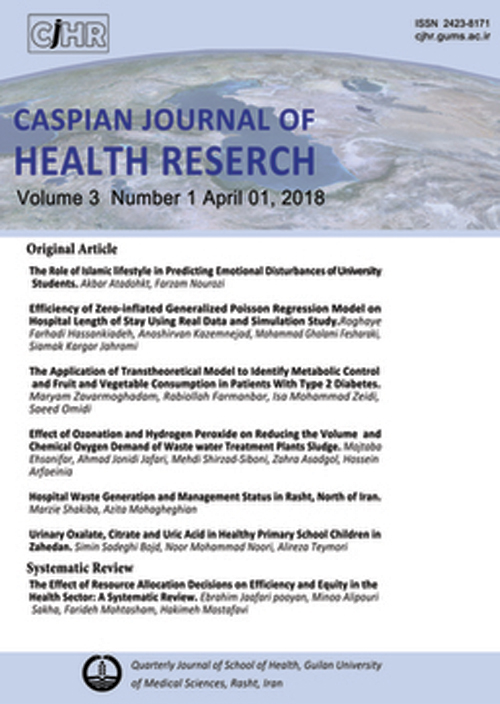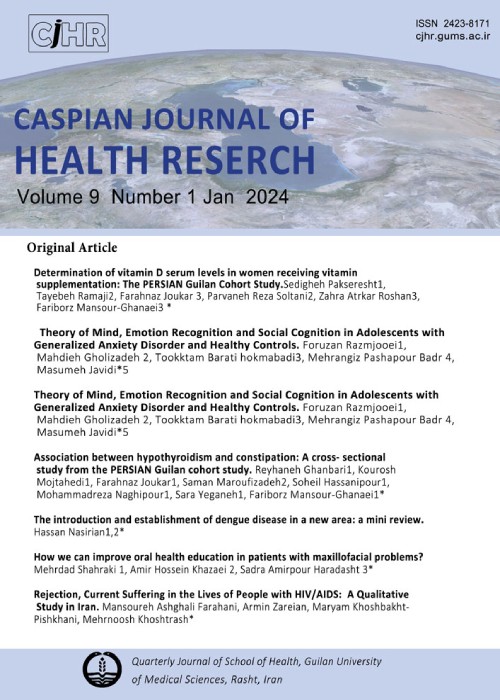فهرست مطالب

Caspian Journal of Health Research
Volume:6 Issue: 4, Dec 2021
- تاریخ انتشار: 1400/11/17
- تعداد عناوین: 6
-
-
Pages 109-110
Vaccination is a fundamental approach in mitigating the COVID-19 pandemic. But there are challenges confronting successful COVID-19 world-wide vaccination. This editorial pointed out to the doubt on long-lasting immunity gained from vaccination, vaccine hesitancy and inequity in vaccine access as windering issues facing the global combat against COVID-19.
Keywords: COVID-19, Equity, Pandemic, Vaccination Refusal -
Pages 111-120Background
Since various studies indicate differences in the case fatality rate of SARS-CoV-2 in different settings, it is vital to elucidate the clinical and laboratory parameters. This would be helpful in identifying individuals who are susceptible to adverse outcomes, thereby targeting essential health interventions to resource poor settings. This study aimed to determine the clinical and laboratory predictors of mortality due to COVID-19.
Materials & MethodsIn this case control study, we included 162 adult inpatients who died due to COVID-19 from May 2020 to February 2021, as cases (n=81) and those discharged as controls (n=81). Demographic, clinical, treatment, and laboratory data was extracted from medical records and electronic database and compared between survivors and non-survivors. Univariate analysis and multivariable logistic regression methods were used to identify the risk factors associated with in-hospital death.
ResultsComorbidities were present among 82 (50.6%) participants. Hypertension was the most common comorbidity 99(61.1%) followed by diabetes mellitus 92 (56.8%) and coronary artery disease 55(34%). Multivariable logistic regression model showed that cardiovascular disease (OR=5.80, 95%CI: 1.09–47.55, P=0.011), decreased oxygen saturation (OR=33.68, 95%CI: 2.81–403.80, P=0.006), elevated CRP (OR=1.16, 95%CI: 1.01–1.32, P=0.026), and serum creatinine (OR=3.26, 95%CI: 1.02–11.55, P=0.047) were the significant predictors of mortality.
ConclusionThis study found that comorbidities such as CAD, elevated serum creatinine, elevated inflammatory markers, and decreased O2 saturation were independent predictors of mortality among COVID-19 patients.
Keywords: COVID-19, Mortaliy, Case-control study -
Pages 121-127Background
Pain perception in individuals with migraine is very important and is influenced by various factors. The aim of this study was to investigate the role of alexithymia and self-efficacy with pain perception in women with migraine.
Materials & MethodsThis cross-sectional study was performed in women with migraine referred to medical centers in Rasht in 2021. Using convenience sampling method, 160 women with migraines participated in the study and answered the demographic information questionnaire, Toronto Alexithymia Scale (TAS-20), General Self-Efficacy Scale (GSE) and McGill Pain Questionnaire (MPQ). Data was analyzed using Pearson correlation coefficient and linear regression model.
ResultsOf total, 152 women responded to the questionnaire (response rate= 95%). The mean age of study participants was 32.86±8.5 years. Pain perception was negatively associated with selfefficacy (r=-0.28; P=0.001) and positively associated with alexithymia (r= 0.20; P=0.001). The results of linear regression also showed that self-efficacy and Externally-Oriented Thinking (EOT) subscale explained 13% of the variance in pain perception.
ConclusionSelf-efficacy and externally-oriented thinking were significant contributors of pain perception in women with migraine. These variables can be considered for adopting coping strategies in patients experiencing migraine pain.
Keywords: Alexithymia, Self-efficacy, Pain perception, Migraine -
Pages 129-136Background
Irritable Bowel Syndrome (IBS) is one of the most common gastrointestinal disorders and is usually associated with abdominal pain. This study aimed to compare the effectiveness of mindfulness and neurofeedback on quality of life in patients with irritable bowel syndrome.
Materials & MethodsThe present study was a pretest-posttest control group design with a two-month follow-up. The study population included all women with irritable bowel syndrome referred to gastroenterology centers and clinics of Qazvin city in 2019. Patients were selected by convenience sampling and randomly assigned into two experimental and one control groups (n=45). The experimental groups underwent Mindfulness-Based Cognitive Therapy (MBCT) and Neurofeedback (NFB). The Rome-III diagnostic criteria form and the WHOQOLBREF were administered. Data were analyzed using repeated measure analysis of variance.
ResultsThere was significant difference between NFB and control group for total quality of life and all its components. The mean between-group difference (MD) of total quality of life score in NFB compared to control group was 21.2±2.58 in post-test and 15.4±2.35 in follow-up (P<0.05). MBCT group was significantly different with the control group in component of general health both in post-test (MD= 0.93±0.53) and follow-up (MD=0.73±0.53), (P<0.05).
ConclusionNFB therapy considerably improved the quality of life of patients with IBS that was remained after two months of follow-up, while MBCT was only effective on improvement of general health in comparison with the control group.
Keywords: Cognitive Behavioral Therapy, Mindfulness, Neurofeedback, Quality of life, Irritable Bowel Syndrome -
Pages 137-145Background
Due to the importance of work-family conflict, it is necessary to find its relationship with organizational variables like perceived organizational support. The present study investigated the relationship between work-family conflict and perceived organizational support in nurses of Kurdistan University of Medical Sciences.
Materials & MethodsThe present study was a descriptive cross-sectional study conducted on 300 nurses working at educational hospitals of Kurdistan University of Medical Sciences, Iran. A three-part questionnaire including demographic information, Carlson’s family-work conflict, and perceived organizational support of Eisenberg was used. Descriptive statistics and analytical statistical tests (Mann-Whitney and Kruskal-Wallis) and Spearman correlation coefficient were used.
ResultsThe majority of the participants were female (64.2%) and married (55.9%). Work-family conflict was slightly higher than the mean. The dimensions of time-based work-family conflict (10.79±2.95) and strain-based work-family conflict (10.66±2.72) had the highest scores compared to other dimensions of work-family conflicts. Perceived organizational support was less than mean and there was a negative correlation between work-family conflict and perceived organizational support (r=-0.21, P=0.001).
ConclusionThe present study showed the importance of paying attention to reducing workfamily conflict by increasing perceived organizational support. Therefore, reducing the dimensions of work-family conflict is necessary and organizational managers should increase organizational support for nurses and thus reduce the conflict between nurses and family work.
Keywords: Nurse, Conflict, Work, Family -
Pages 147-150Background
Oral papilloma is benign lesion while there is concern about high-risk types of Human Papilloma Virus (HPV) for cancer.
Case PresentationThe patient was a 30-year-old woman who presented to the School of Dentistry, Semnan University of Medical Sciences for orthodontic treatment. Intraoral examinations revealed a prominent white papule on the tip of the tongue. Histopathologic exanimation revealed the proliferation of hyper keratinized stratified squamous epithelium arranged in projections with fibrovascular connective tissue cores, cell irregularity with hyperchromatic nucleus and koilocytes within the epithelium which confirmed the diagnosis of squamous papilloma (SP) with mild to moderate dysplasia. The patient was instructed to take care of the sexual behaviors and the injection of Gardasil vaccine was recommended. A month later, there was no evidence of a lesion.
ConclusionThough SPs are common lesions in the oral cavity, occurrence of dysplasia on SPs on the anterior part of the mouth is rare. Surgical removal supplemented by administration of Gardasil vaccine can be the treatment of choice in these cases. The significance of close attention to the oral lesions and consultation with an Oral and Maxillofacial Medicine Specialist is highly recommended in order to accurate diagnosis and timely treatment.
Keywords: Papilloma, Oral Cancer, Tongue Cancer, HPV Infection


